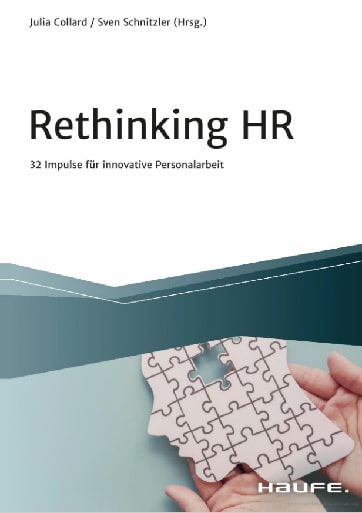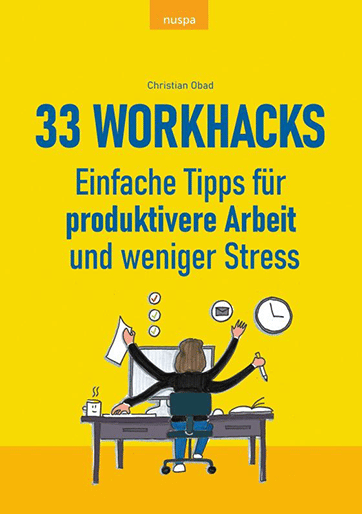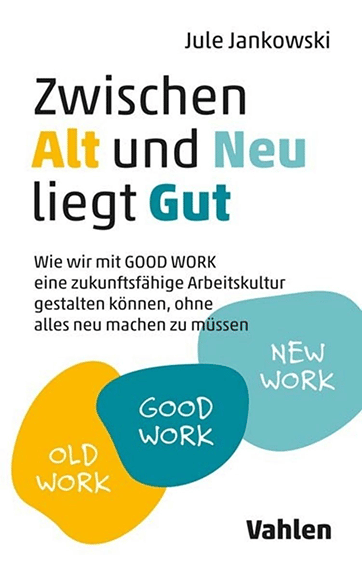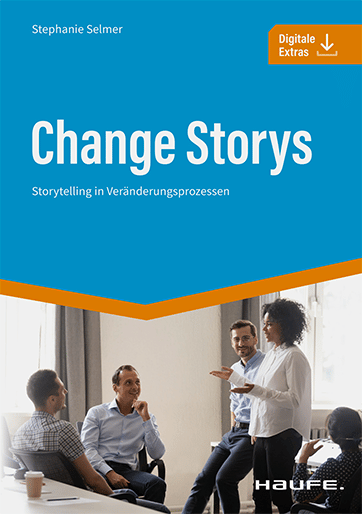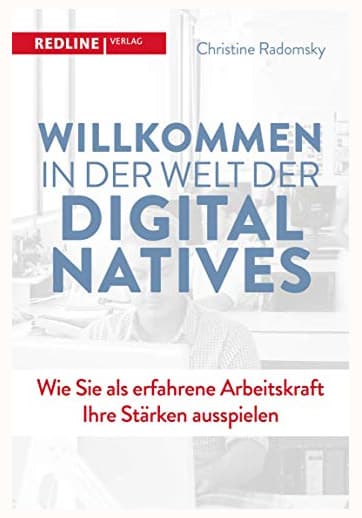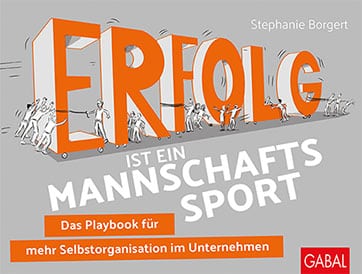Rating: Really wonderful!
“There’s more treasure in books than pirate’s booty on Treasure Island… and best of all, you can enjoy that wealth every day of your life.” – Walt Disney
“Of all the worlds man has created, that of books is the most powerful.” – Heinrich Heine
“From one’s parents one learns to love, to laugh, and to walk. But it is only when you come into contact with books that you discover you have wings.” – Helen Hayes
Reading is considered the second most beautiful thing in the world. Although I’m not clear what the most beautiful thing is supposed to be, I’d like to recommend some really wonderful books again. This time by and with Julia Collard and Sven Schnitzler, Christian Obad, Jule Jankowski, Stephanie Selmer, Janine Tychsen, Katharina Boguslawski, Christine Radomsky and Stephanie Borgert.
Rethinking HR
32 Impulses for innovative personnel work
(32 Impulse für innovative Personalarbeit)
Julia Collard and Sven Schnitzler
Julia: It’s about the “work-life journey” of people from many different perspectives. From choosing a career to offboarding. It was a spontaneous social media idea – Julia Wieland’s question on Twitter about current HR books inspired us to call for a blog parade or book sprint.
Via Bernd Slaghuis we got the connection to Haufe and between October and Christmas 2020 – quasi in the middle of the 2nd Corona Lockdown – the contents arrived.
For whom did you write the book?
Sven: I would rephrase the question: Not for whom, but with whom? After all, there are 40 authors who have taken a look at the human resource from the most diverse perspectives. Above all, however, from their own perspective as such a “resource”. The result is a kind of HR customer journey. Not an instruction manual for people and people business by any stretch of the imagination, but perhaps a few impulses that help us to understand each other better and to finally really focus on people.
And why did you write it?
Julia: It practically forced itself on us! 😉
Kidding! We found it really exciting to put these different building blocks together. Actually, we were “only” service providers in the process, but connecting the individual perspectives feels a bit like building bridges.
So when it comes to the “why” (as marketing people we quite like that “why”😊):
- We found it exciting to put all these building blocks together. In fact, we were “only” service providers in the process and perhaps a bit of bridge builders in connecting the individual stories.
- Because it is unique in this form. We are quite immodest about that. 😎
- Because HR is much more than personnel management in a company; because everyone will find themselves in one place or another.
- And because it is something “with people”. It doesn’t follow a trend and yet it sets a trend – namely the trend towards listening to the stories people have to tell and want to experience. “Share your story” is our slogan – and the call to #RethinkingHR could not have been better!
Here you can find more information about the book “Rethinking HR”.
33 Workhacks
Simple tips for more productive work and less stress
(Einfache Tipps für produktivere Arbeit und weniger Stress)
Christian Obad
Christian: It’s about the very banal question of how we can increase our work effectiveness and reduce stress at work.
Why did you write the book?
Christian: I support companies and teams in positioning themselves for the future. This is about working on the system and it has to be done while the business is running. Again and again, I experience that teams are already so overloaded that they no longer have the capacity for this important, future-oriented work. Work overload and work compression is often the keyword. That is why the first step is often to look at how to free up capacity for this work.
And of course there is a myriad of literature on these issues and yet the same problem keeps coming up. Obviously, many of the models are too big and complex, especially for people who are already at their limit. My goal was therefore to compile the most effective tips and prepare them in such a way that they can really be tried out quickly and easily. But only one hack at a time! And with each tip applied, the situation improves in small steps – for you personally and for the team. Then there is time again for the important questions about the future.
And who should read the book?
Christian: The book is for working people who have the feeling of being at the limit or not really getting ahead in their work. When I wrote it, I had office people in mind, but in the meantime I’ve also had feedback from other areas that the book is useful.
But one thing is important: reading is useless. The individual, small workhacks are easy to implement and only those who are willing to try them out and apply them have a chance of improvement. That’s why there is also a reflection page to fill in for each tip. So it’s more of a workbook than a reading book.
Here you can find more information about the book “33 Workhacks”.
Between old and new lies good
(Zwischen Alt und Neu liegt Gut)
How we can shape a sustainable work culture with GOOD WORK without having to do everything anew
(Wie wir mit GOOD WORK eine zukunftsfähige Arbeitskultur gestalten können, ohne alles neu machen zu müssen)
Jule Jankowski
Jule: It’s about a constructive and concrete view of good cooperation and how this cooperation can succeed without having to redo everything.
In my observation, quite a few people are unfamiliar with the term “new work”. For so long, the label “new” has been used to discuss a programmatic setting that logically can no longer be new at some point. And so this valuable idea degenerates into an empty proper name. That is a pity. The insights from the book come, among other things, from my learning chronicle in podcast form called GOOD WORK. In over 140 episodes, I have recorded the specific changes of the past two years in a structured way in conversations with thought leaders and people from the middle of the working world, examined them and summarised them. The result of this is, among other things, five GOOD WORK principles. They form the inner framework of the book.
Why did you write the book?
Jule: The abrupt remotification of our so-called knowledge society – triggered by the pandemic – was an occasion for me to write down and record what we are currently gathering in terms of learning insights on an individual and organisational level. In March 2020, I followed my intuitive hunch that we are facing an irretrievable transformation of forms of collaboration. As a social researcher by birth, I couldn’t help but look closely and draw conclusions. We should urgently put these lessons to good use. For we are currently seeing that the crises are coming thick and fast.
And who should read the book?
Jule: Everyone who is seriously committed to the sustainability of our work TODAY and wants to get involved. There is a lot of talk about the future of work at the moment. Future viability – as distinct from this – is a perspective for action in the present. Those who always feel a certain unease within themselves, a natural scepticism towards fashionable promises and prefer to get to the essential core, will enjoy reading “Zwischen Alt und Neu liegt Gut”. It is a fervent plea for essentiality.
Here you can find more information about the book “Zwischen Alt und Neu liegt Gut”.
Change Stories
(Change Storys)
Storytelling in change processes
(Storytelling in Veränderungsprozessen)
Stephanie Selmer
Stephanie: Besides what the title already reveals, it is about good change communication. Change projects still too often rely on numbers, data and facts and thus try to convince people of a change on an emotional level. In my book, I show how change communication can be built on storytelling and thus strongly target the emotional side.
Why did you write the book?
Stephanie:
Storytelling is very present in marketing and sales and is traded like a secret weapon. Many change managers have long recognised this and want to use storytelling for communication in their projects. However, they are always faced with the same problems and questions:
- Is a change story better a real story or a made-up story?
- What do I even need and how do I start collecting all the information?
- And how can I be sure that I haven’t overlooked anything and don’t have to turn around the whole story later?
For storytelling in change projects, there is often exactly one attempt, and it should fit. I’ve had a few communications go sour myself and I know the pressure you’re under in that situation. Sometimes there were moments when I wished I hadn’t tried.
With my book, I want to give those responsible for change a guideline and thus also a sense of security. They should know what they are getting into, be well equipped to start developing their change story and be able to use it for the whole project.
And who should read the book?
Stephanie: Anyone who has ever wished or wishes that change communication was less about numbers, dates and facts.
Here you can find more information about the book “Change Storys”.
Women, take the lead!
(Frauen, geht in Fuehrung!)
90 days leadership muscle training
(90 Tage Fuehrungsmuskeltraining)
Janine Tychsen
Janine: My book is aimed at women for two reasons: Firstly, I am a woman myself with the wonderful gift of being able to receive other women’s emotions and energies unfiltered, classify them and direct them into positive orbits. Secondly, in my 45 years of life I have lived through pretty much every “female leadership pain” inside and out and can pick up women where they are at the moment.
At the heart of the book are my coaching tools, tested over many years, which I share in full detail. This allows readers to work with and on themselves at their own pace. On top, I interviewed ten women in public life to underscore my self-leadership experiences. From Tatjana Kiel, Simone Menne to Fränzi Kühne, Verena Pausder to Claudia Kessler, Karin Heinzl and other great women, this one message runs through my book and all of our lives: You are not alone!
In my experience, there is a leader in every woman. “Women, take the lead!” can be a solution strategy and a reliable life and career companion. The first book part “You are good enough – you just don’t know it yet” lays the foundation for solid self-leadership. The second book part “Letting Go – Realigning – Emerging” deals with the most diverse facets of leadership and the development of personal answers. And the third book part is the royal class of leadership: “Be a leader – not a boss”. Leading as a role model is the consequence of solid self-leadership and clear, authentic leadership that impacts, moves and changes.
Why did you write the book?
Janine: The book is my appeal to every woman to deal with her fears, doubts, her strengths, values and uniqueness. The self-coaching exercises lead women back into their power, into their true being. The energy of the book makes it easier to shape one’s life and career in a self-determined, creative and non-conformist way.
I myself worked in business and science for over 20 years – many of them in leading positions. I consciously chose this steep learning curve. But when I hit the famous glass ceiling again and again, the most courageous step of my life followed: I gave up the security of the corporate world to become ME. I was pulled by a strong mission: to encourage every woman to lead herself and others with personality: With all the rough edges. In all beauty and discomfort. With all possibilities. Self-determined, creative and non-conformist.
And who should read the book?
Janine: My book is not only suitable for women in leadership positions. I wrote it for every woman who wants to believe more strongly in herself, her abilities and her impact. Inner Work First is the motto as a foundation for personal fulfilment and professional success. Women who feel addressed by my energy, my words and my being should read the book. But beware: it carries a certain risk, because readers will get to know themselves better and perhaps uncover things they did not want to see before. From my point of view, this courage is definitely worth it!
Here you can find more information about the book “Frauen, geht in Fuehrung”.
Your creative avatar
(Dein kreativer Avatar)
How to generate innovative ideas and convince others of them
“Wie du innovative Ideen generierst und andere von ihnen ueberzeugst)
Katharina Boguslawski
Katharina: The entertaining creative guidebook DEIN KREATIVER AVATAR
shows you how to generate innovative ideas and convince others of them. It is a magic box of methods that encourage and empower us humans to bring our valuable ideas into the world.
By the end of this book you will know how to
- fill yourself with the courage of ideas,
- generate ideas comfortably in your everyday life,
- master brainstorming with creativity methods,
- convince sceptics of your ideas and
- shine in creative teamwork.
Why did you write the book?
Katharina: I wrote a book like I would have liked to read about creativity: from the science of brainstorming in everyday life to analytical creativity methods to pitching ideas to the boss. And the whole thing written in an entertaining way with illustrations, self-tests, quizzes, …
This is the only way we can enjoy creativity at work and come up with ideas that make our world safer and more beautiful.
And who should read the book?
Katharina: Career starters should read the book so that they can shine in front of their boss and colleagues with ideas at the push of a button from day one. And ambitious group leaders under pressure to innovate should also read the book so that they make themselves irreplaceable for the company.
Here you can find more information about the book “Dein kreativer Avatar”.
Welcome to the world of digital natives
(Willkommen in der Welt der Digital Natives)
How to play to your strengths as an experienced worker
(Wie Sie als erfahrene Arbeitskraft Ihre Stärken ausspielen)
Christine Radomsky
Christine: My book is intended to encourage and enable people with professional experience to understand the digital transformation and develop important skills for the future.
Part 1 takes them on a journey through the digital transformation of the world of work: Which new technologies are important and what are they good for? How are cooperation, leadership and organisation changing? What skills do professionals need in the new world of work?
Part 2 invites them to explore their personal path to more digital and future competence. It is about self-determined learning with digital resources, networking, “self-marketing” and new career strategies. Those who like can set themselves a concrete competence or career goal while reading. Self-coaching questions help with the implementation.
Equipped in this way, experienced professionals can not only have their say on the topic of digitalisation, but also more easily master and help shape changes in the workplace.
Why did you write the book?
Christine: Honestly? I’m annoyed by the constant complaints about the “shortage of skilled workers”. If there is one – why do we afford to largely ignore the valuable potential of experienced professionals in the digital transformation? When it comes to new, attractive tasks, many managers and HR managers prefer to address “digital natives”. Because experienced professionals are often overshadowed, they should confidently demand further training and development opportunities. The best way to do this is to be familiar with the digital transformation and know what strengths you can and want to bring to it.
It is important to me that employees with professional experience help shape the changes in their workplace and open up attractive, future-oriented jobs. After all, “old hands” possess valuable strengths that complement the digital insouciance of the younger ones well. They also have a great ability to learn, curiosity and a willingness to create. Those who also develop their “digital fitness” simply have more opportunities in the new world of work. The book is intended to help with this.
And who should read the book?
Christine: Experienced, curious professionals who are willing to learn will benefit the most from this book. More precisely: women and men who already have years of experience in the profession and now want to make themselves fit for the digital transformation. No matter whether they “only” want to become more confident in their job or are looking for a new professional challenge.
Here you can find more information about the book “Willkommen in der Welt der Digital Natives”.
Success is a team sport
(Erfolg ist ein Mannschaftssport)
The playbook for more self-organisation in the company
(Das Playbook für mehr Selbstorganisation im Unternehmen)
Stephanie Borgert
Stephanie: There is hardly a company that is not undergoing an “agile transformation”. Away from rigid hierarchies, towards New Work, the models and methods often promise creative, enthusiastic employees and long-term success. Reality paints a different picture. Many agile initiatives have long since been declared a failure and have been lost in the operational hustle and bustle of business. Supposedly. Because agility is still viewed too superficially and reduced to the methodologies. And so extended team responsibility meets group dynamics and “modern” leadership meets old images of people. The organisations and thus the people in them are not prepared for the high level of “interpersonal” that they have to deal with when the rigid corset of guidelines, processes and control is cut open.
With this book I provide knowledge and give security for the path to an agile organisation. In it, I take up problems and open questions from practice and answer them as crisply as possible and as extensively as necessary. For example, it deals with positions in a team and their effects, the “I” in the team, regulating conflicts, reflecting on one’s own understanding of “organising” and provocations on the topic of leadership. It is a workbook full of interventions, philosophical units and reflections.
Why did you write the book?
Stephanie: In the many years of my work with agile teams, agile transformations and interventions, I have noticed again and again that teams, and therefore people, lack a lot of preparation. How do we deal with conflicts when we no longer have a supervisor regulating them for us? What about power in our team? The more self-determination, the more each team has to negotiate for itself. I want to contribute a collection of fundamental aspects to this with the book and thus provide helpful thoughts and impulses.
And who should read the book?
Stephanie: In principle, everyone who works with others. However, the focus is on “more self-organisation” and the effects that arise from it. This makes the book particularly useful for people who are thinking about, participating in or even contributing to transformations. People who do not want to think about their own thinking should therefore not start the book.
Here you can find more information about the book “Erfolg ist ein Mannschaftssport”.
What do you find really wonderful?
Of course, opinions differ as to what is ” really wonderful”. Some will find this contribution wonderful, others may not. Personally, I am always amazed at what motivates people to write books. Especially the reasons that go along with it give it an individual touch. And that, in my view, deserves exactly one rating: truly wonderful!
Notes:
If you like the post or want to discuss it, feel free to share it with your network.
Here you can find more articles with book recommendations:

Michael Schenkel
Head of Marketing, t2informatik GmbH
Michael Schenkel has a heart for marketing - so it is fitting that he is responsible for marketing at t2informatik. He likes to blog, likes a change of perspective and tries to offer useful information - e.g. here in the blog - at a time when there is a lot of talk about people's decreasing attention span. If you feel like it, arrange to meet him for a coffee and a piece of cake; he will certainly look forward to it!
